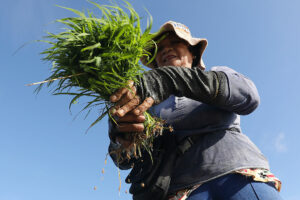




Philippines Trade Update: Exports momentum continues
 DOWNLOAD
DOWNLOAD

Quarterly Economic Growth Release: More BSP cuts to come
 DOWNLOAD
DOWNLOAD

Monthly Economic Update: Fed catches up
 DOWNLOAD
DOWNLOAD


Agricultural output likely flat in Q1

AGRICULTURAL PRODUCTION was likely flat in the first quarter, even as the livestock and poultry subsectors are expected to have performed well, analysts said.
“I have no great expectations. I think we will still be flat. The luckiest thing that can happen is that there will be some growth but minimal,” Elias Jose “Bong” M. Inciong, president of the United Broiler Raisers Association, said in a phone interview.
“It would be more or less the same as the first quarter of last year. Based on the breeders in place, the greater production should be during the second quarter,” he added.
Farm output contracted by 0.3% in the first quarter of 2022.
“I think it will be somewhat flat. It will be difficult to get towards a percent growth, but this will be about 0-1%, perhaps within that range,” Danilo V. Fausto, president of the Philippine Chamber of Agriculture and Food, Inc., said by phone.
“We will be able to achieve growth for the entire agricultural sector because the livestock sector will pull up the growth,” he added.
The Philippine Statistics Authority (PSA) is scheduled to release first-quarter farm data on May 10.
Agricultural production shrank by 0.1% in 2022, marking the third straight year of contraction, as crop and fishery output declined.
Data from the PSA showed the full-year value of production in agriculture and fisheries declined slower than the 1.7% contraction in 2021.
It also missed the Department of Agriculture’s (DA) 1.2%-1.5% full-year growth target.
Farm output declined by 1% in the fourth quarter of 2022, reversing a 0.5% growth a year earlier and 1.6% growth in the third quarter of 2022.
Only the livestock and poultry subsectors posted increases in agriculture production in the fourth quarter, growing by 2.5% and 1.9%, respectively.
The DA sees agricultural output growing by 2.5% this year.
Data from the National Livestock Program showed the domestic production of chicken is expected to hit 2.08 million metric tons (MT) this year, liveweight, with demand at about 1.6 million MT.
Mr. Inciong said the resurgence of type H5N1 avian influenza outbreaks had a huge impact on the layers but not on the broilers.
“The production cycle of layers can reach up to more than 18 months, while for broilers it is only 35 days,” he said. “The period for possible exposure to the virus is minimal for the latter.”
The Bureau of Animal Industry said six barangays had avian influenza cases in nine regions as of April 28.
National Livestock Director Ruth S. Sonaco earlier said the poultry industry was recovering faster than the livestock industry.
Mr. Inciong said the African Swine Fever (ASF) is a “far more challenging virus” compared with avian influenza.
“The production of hog fatteners is about five to six months — longer exposure.”
Meanwhile, Mr. Fausto said commercial hog farms are recovering after building their biosecurity protocols against ASF.
Latest data from the Animal Industry bureau showed ASF was still active in 78 villages in seven regions as of April 28.
Roehl M. Briones, a senior research fellow at the Philippine Institute for Development Studies, said by phone the ongoing clinical trials and field testing for vaccines showed slow progress.
“There were earlier hopes that the vaccine would be a game-changer but apparently, the efficacy wasn’t that higher than earlier imagined,” he said. “That’s still a lot of trial that needs to be done on a really effective vaccine.”
Crops and fisheries
Meanwhile, Mr. Fausto said crops, in particular palay or unmilled rice, have seen a good harvest so far amid favorable weather conditions.
“Usually, the first quarter has good weather especially in crops. We harvest good especially in the irrigated area and in our vegetable area because of a good weather,” he said.
Crop production, which accounts for more than half or 59.1% of total agricultural output, fell by 1% in the fourth quarter and full-year 2022, reversing the 2.6% and 2.2% expansion in the fourth quarter and full-year 2021.
PSA data showed fourth-quarter crop production declined by 2.5% for palay from 0.2% growth a year earlier and 6.9% for corn from 28.6% growth.
In terms of input costs, Mr. Fausto said fertilizer prices went down to PHP 1,200 a bag of urea from about PHP 3,000 a bag previously.
The Philippines imports most of its fertilizer needs.
However, he warned of the possible impact of El Niño in the second half. The Philippine Atmospheric, Geophysical and Astronomical Services Administration this week said El Niño is likely to persist until the first quarter of 2024.
Meanwhile, Mr. Briones said the fishery sector’s performance is “always an open question.”
“It has always been difficult to predict exactly how it’s going… It is highly erratic. I wouldn’t know one way or another whether the fishery sector would finally grow or continue to contract,”
The production of commercial fisheries likely improved, while municipal fisheries could have been challenged by the lack of post-harvest facilities, Mr. Fausto said.
“We cannot expect an increase in fisheries because in the agriculture sector, it is only the fishery sector that is going down,” he added.
PSA data showed fishery production slumped by 6.6% in the fourth quarter of 2022, worse than 1.1% growth a year earlier. It accounted for 13.8% of farm output during the period.
For the full year, fisheries shrank by 5%, reversing a 0.1% increase in 2021.
Mr. Briones said while the oil spill in Oriental Mindoro could affect the sector, the impact might not be severe. — By Sheldeen Joy Talavera
This article originally appeared on bworldonline.com





 By BusinessWorld
By BusinessWorld